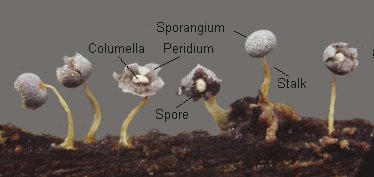 Members of this class are commonly referred to as slime moulds. These have been thought to belong to both the animal and fungi kingdoms at one time or another. It's now known that they are quite unrelated to animals and fungi, and are now classified in the Kingdom Protista.
Members of this class are commonly referred to as slime moulds. These have been thought to belong to both the animal and fungi kingdoms at one time or another. It's now known that they are quite unrelated to animals and fungi, and are now classified in the Kingdom Protista.However, slime moulds do exhibit characteristics of both fungi and animals. In the feeding stage, the slime moulds move about as a mass of protoplasm (image to the right), (the plasmodium) feeding on bacteria, spores, and other organic matter much like an amoeba. When the food supply is exhausted or other unfavourable conditions occur, the plasmodium changes, taking on the appearance of a fungus.

 Below is a detailed a life cycle, but not all slime moulds will follow this exactly.
Below is a detailed a life cycle, but not all slime moulds will follow this exactly.



